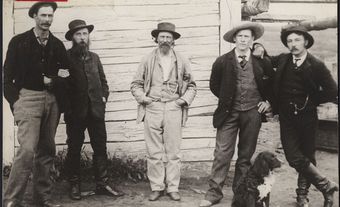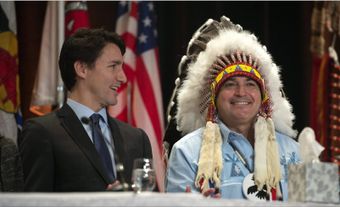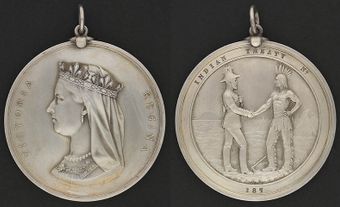The Indian Act was first created in 1876. A new version was created in 1951. Since then, the Act has been revised several times. The main goal of the Act was to force First Nations peoples to lose their culture and become like Euro-Canadians. The Indian Act does not affect either the Métis or Inuit.
(This article is a plain-language summary of the Indian Act. If you are interested in reading about this topic in more depth, please see our full-length entry, Indian Act.)
The Indian Act, 1876, gave a lot of power to the Department of Indian Affairs (see Federal Departments of Indigenous and Northern Affairs). For example, the agents of the department decided who could receive rights and benefits (see Indian Agents in Canada). Also, they controlled the elections that First Nations people held.
At the turn of the 20th century, the Indian Act was amended (changed) many times. Some of the more important amendments were about schools and First Nations religion. They forced First Nations children to attend residential schools. And, they made it illegal for First Nations to practice their religious ceremonies.
Other amendments made it difficult for First Nations people to make a land claim and keep their status of “Indian” (see Indian Status.) Losing this status meant losing rights, and not being able to receive services and benefits (see Treaties with Indigenous Peoples in Canada).
After the Second World War(1939-45), changes were made to the Indian Act once again. In 1951, a new version was created. The revised Act allowed First Nations people to practice their religion and bring their land claims to court. They also gave women the right to vote in band council elections. However, not all the changes were beneficial to First Nations people, especially First nations women. They could lose their status of “Indian” if they married a non-status man (see Women and the Indian Act.)
In 1969, the government of Prime Minister Pierre Elliot Trudeau argued in its “White Paper” that all First Nations people should lose their Indian Status (see The White Paper, 1969). Trudeau wanted First Nations people to completely assimilate into Canadian society. This made many First Nations people angry because they would lose many of their rights and benefits. In protest, Harold Cardinal, the President of the Indian Association of Alberta, issued the “Red Paper.” First Nations opposition to the “White Paper” was so strong that the Trudeau government backed down.
In the 1980s, changes were made to the Indian Act again because many individuals and groups (such as the United Nations Human Rights Commission) believed it violated human rights. To make these changes the government passed Bill-31. Among other things, it gave status to many First Nations people who had been denied it for unfair reasons.
The Indian Act has been, and still is, controversial. Since the 1990s, First Nations people have made many recommendations to reform the Act. As a result, in 1999, the federal government passed the First Nations Land Management Act. First Nations governments gained a little more power as a result. It did not, however, abolish the Indian Act.

 Share on Facebook
Share on Facebook Share on X
Share on X Share by Email
Share by Email Share on Google Classroom
Share on Google Classroom









